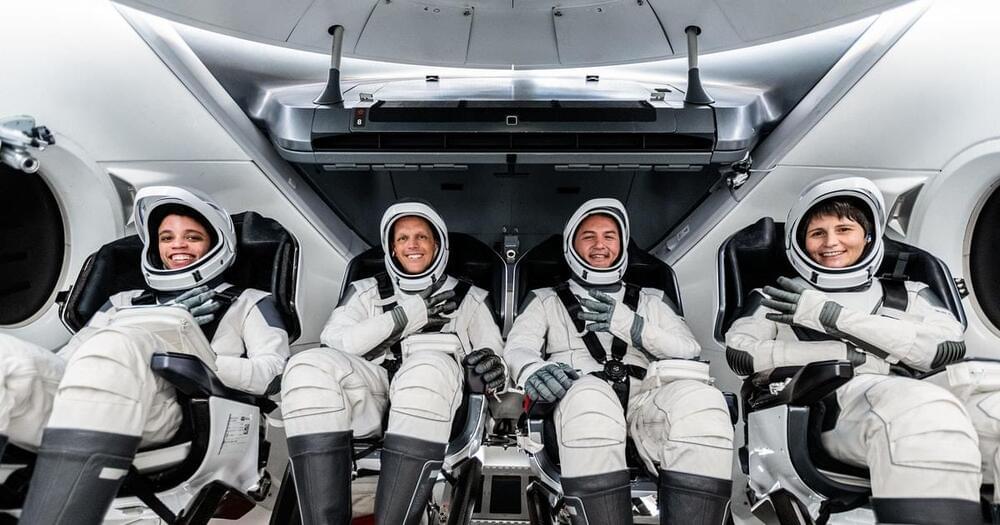Apr 19, 2022
How an accidental discovery made this year could change the world
Posted by Dan Kummer in category: energy
A lucky discovery involving lithium-sulfur batteries has a legitimate chance to revolutionize how we power our world.
A lucky discovery involving lithium-sulfur batteries has a legitimate chance to revolutionize how we power our world.
The four Ax-1 astronauts will get to spend about 12 extra hours on the orbiting lab.
The first-ever fully private crewed mission to the International Space Station will get to spend 12 extra hours aboard the orbiting lab.
The four astronauts of Ax-1, a mission organized by Houston company Axiom Space, had been scheduled to depart the station in their SpaceX Dragon capsule at 10:35 a.m. EDT (1435 GMT) on Tuesday (April 19) and splash down off the coast of Florida early Wednesday morning (April 20).
SpaceXs brand-new Dragon spacecraft – named “Freedom” by the Crew-4 astronauts – arrived at Kennedy Space Center’s Launch Complex 39A on April 16, 2022, after making the journey from SpaceX’s processing facility at nearby Cape Canaveral Space Force Station in Florida. After Dragon is mated to the SpaceX Falcon 9 rocket, the launch vehicle will roll out to the pad and be raised to the vertical launch position.
Liftoff is scheduled for 5:26 a.m. EDT on Saturday, April 23. NASA’s Crew-4 mission is the fourth crew rotation flight on a SpaceX Dragon spacecraft and Falcon 9 rocket. NASA astronauts Kjell Lindgren and Bob Hines will serve as mission commander and pilot, respectively, and NASA astronaut Jessica Watkins and ESA (European Space Agency) astronaut Samantha Cristoforetti, will join as mission specialists.

If all goes according to plan, Jessica Watkins will become the first African-American woman to make a prolonged ISS stay.
Experiments on how anaesthetics alter the behaviour of tiny structures found in brain cells bolster the controversial idea that quantum effects in the brain might explain consciousness.
Deep learning–based language models, such as BERT, T5, XLNet and GPT, are promising for analyzing speech and texts. In recent years, however, they have also been applied in the fields of biomedicine and biotechnology to study genetic codes and proteins.
Circa 2021
As described above, molecular therapeutics enabling expression of a truncated dystrophin have been far developed. However, an unprecedented opportunity to correct the disease-causing mutation has arisen with the advent of Crispr-Cas9 technology (Fig. 1).
Since the generation of a Cas9-transgenic mouse [28], which allowed for pinpoint gene alterations specifically in organs targeted by AAVs encoding for the corresponding guide RNAs (gRNAs), it became clear that the inevitable course of inherited diseases might be altered by Cas9-mediated correction. Although certain limitations were unmasked early on, such as the preference of non-homologous end-joining (NHEJ) over homology-directed repair (HDR) upon enzymatic cleavage of the double stranded DNA by Cas9, or the packaging capacity of AAVs, muscular dystrophies seemed an ideal target for genome editing. DMD mutations inducing Duchenne muscular dystrophy (DMD) seemed particularly well suited, since internal truncations of the protein may lead to a shortened but stable protein with partial functional restitution and a milder disease progression, as seen in the allelic Becker muscular dystrophy (BMD).
Continue reading “Genome editing for Duchenne muscular dystrophy: a glimpse of the future?” »
Death Valley brings the heat, but there are other hot spots on this sweltering planet.
Summers can be hot in Death Valley, California. In fact, it is likely the hottest place on Earth—ever. Especially on Sunday, August 16 and—again—on June 17, 2021. The mercury spiked to a sweltering 130 degrees Fahrenheit in the national park, drawing crowds of tourists who flocked to take pictures with the park’s digital thermometer.
Peter Sjöstedt-Hughes » IAI TV.
The hard problem of consciousness is the most pressing unsolved mystery in both philosophy and science. To solve such a problem, we are going to need revolutionary ways of thinking. Philosopher of mind, Peter Sjöstedt-Hughes, argues higher spatial dimensions might hold the key to the hard problem.
